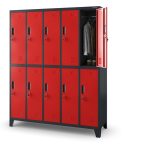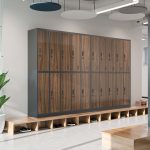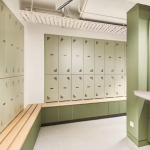Gym lockers are essential for members to store their personal belongings. A well-designed, secure, and reliable locker not only offers convenience and comfort but also enhances the overall user experience of the gym. However, with various types, designs, and functions of lockers available in the market, how do you choose the most suitable one for your gym? This article will provide practical advice to help you make the best decision.
1. Understand the Needs of the Gym
Before choosing lockers, it is crucial to understand the specific needs of the gym. Different types of gyms may have varying user demographics, usage habits, and facility setups.
Number of Members: The number of members directly impacts the quantity and size of lockers required. Larger gyms need more lockers and may need to offer different sizes to meet diverse member needs.
Member Type: If the gym mainly caters to high-end members, you may want to choose luxurious and uniquely designed lockers. For gyms catering to regular members, functional and reasonably priced lockers may be more appropriate.
Usage Frequency: The frequency of locker use is also important. If the gym mainly serves white-collar workers or busy individuals, lockers with higher convenience and smart features (such as electronic locks, app control) may be more favored.
2. Choose the Right Size and Layout
The size and layout of lockers directly affect the user experience. When selecting gym lockers, consider the following:
Single vs. Multiple Lockers: Single lockers are typically for smaller items, while multiple lockers are more suitable for users who need to store different items separately, such as shoes, clothes, and wallets.
Appropriate Size: The size of the lockers should be determined based on the gym’s space and members' needs. If space is limited, you can opt for compact lockers. For members who frequently carry large items, larger, deeper lockers may be more appropriate.
Efficient Layout: The layout of the lockers should consider the flow of users and space utilization. Placing lockers near the entrance can reduce walking distance for members and help avoid congestion.
3. Choose the Right Locking Mechanism
The locking mechanism is a crucial aspect of lockers. Security is the basic requirement for all gym lockers. When choosing a locking mechanism, consider the following options:
Mechanical Locks: Mechanical locks are simple and durable, with intuitive operation, but they require keys, which can be lost. They are suitable for gyms that prefer traditional, stable systems.
Electronic Locks: Electronic locks offer higher security and can be accessed via digital codes, fingerprint recognition, or QR codes. They eliminate the need for keys, avoiding the hassle of losing them. Although more expensive, they are ideal for high-end gyms or those that emphasize convenience.
Smart Locks: With technological advancements, smart lockers are becoming increasingly popular. They are usually controlled via an app, Bluetooth connection, or fingerprint scan, making them quick and convenient, aligning with modern management needs.
4. Choose the Right Material
The material of gym lockers not only affects their appearance but also their durability and security. Common locker materials include:
Metal: Metal lockers are generally stronger and more durable, offering better security. Common materials include steel and stainless steel. Steel lockers are more affordable, while stainless steel is more corrosion-resistant and suitable for damp environments.
Wood: Wooden lockers are often more elegant in appearance and are suitable for high-end gyms or leisure-type facilities. They offer a more stylish, modern design but tend to be more fragile and are not ideal for humid environments.
Plastic or Composite Materials: Plastic lockers are lightweight and resistant to corrosion but may be less secure. Composite materials are often used in modern designs, balancing strength and aesthetic appeal.
5. Consider Ventilation and Easy Cleaning
In a gym, lockers are exposed to high humidity and frequent use, so ventilation and ease of cleaning are essential.
Ventilation Holes: To avoid odors or moisture buildup inside lockers, choose lockers with ventilation holes. This ensures air circulation inside the lockers, reducing bacteria growth and keeping members' belongings dry and clean.
Easy-to-Clean Surfaces: The material of the locker should be easy to clean. Metal surfaces are typically easy to wipe with a damp cloth, while wooden and plastic surfaces require more care to prevent scratching.
6. Smart Features and Modern Management
Modern gyms are increasingly adopting smart management systems to enhance the user experience and optimize operations. Here are some smart features to consider:
Remote Unlocking: You might want to opt for lockers with remote unlocking features, allowing members to unlock lockers using an app or electronic card, eliminating the inconvenience of traditional keys.
Real-Time Monitoring: Some high-end gyms use lockers with monitoring systems to ensure security and prevent misuse or damage.
Smart Management Systems: Smart management systems can automatically track locker usage, helping gym administrators with statistics and management, ensuring maximum locker utilization.
7. Budget and Cost
Finally, when selecting gym lockers, it’s important to consider the budget. High-end smart lockers, while feature-rich and convenient, are more expensive and are suited for gyms focused on innovation and modernization. For regular gyms, lockers with mechanical or electronic locks at mid-range prices are sufficient.
Conclusion
Choosing the most suitable locker for gym involves considering the material, size, locking mechanism, and security, as well as evaluating the gym’s size, member needs, and budget. A well-designed locker system with appropriate features will significantly enhance the user experience for members and improve the gym's overall service quality. When making your choice, aim to provide a secure, convenient, and comfortable storage environment for your members, elevating the overall standard of your gym.





